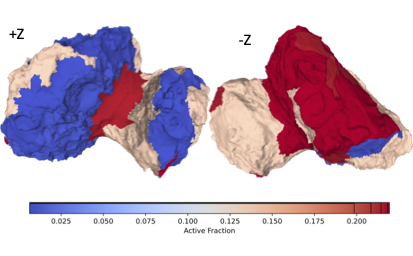Constraints on comet thermal models from Rosetta at 67P/Churyumov-Gerasimenko
- 1Institut für Geophysik und extraterrestrische Physik, Technische Universität Braunschweig, Mendelssohnstr. 3, 38106 Braunschweig, Germany
- 2Aix-Marseille Université, CNRS, CNES, Laboratoire d’Astrophysique de Marseille, Marseille, France
- 3CNRS, Laboratoire J.-L. Lagrange, Observatoire de la Côte d’Azur, Boulevard de l’Observatoire, CS 34229 - F 06304 NICE Cedex 4, France
- 4Alma Mater Studiorum - Università di Bologna, Department of Industrial Engineering, Via Fontanelle 40, I-47121 Forlì (FC), Italy
Comets, thought to be amongst the most primordial of Solar System objects, are distinguished by their activity, i.e. the insolation driven ejection of gas and dust from their surfaces. The exact mechanisms of the outgassing and dust ejection remain an important open question in planetary science, relating as it does to the structure, composition, and thermophysical properties of the surface material. Various thermophysical models (see e.g. [1,2,3]) have been proposed to explain the activity seen by Rosetta at 67P/Churyumov-Gerasimenko, with these often compared to the total outgassing rate. Another directly observable effect of the activity, however, is the resultant non-gravitational force and torque on the cometary nucleus, which can alter its trajectory and rotation state. Understanding the effect of non-gravitational forces on the dynamics of a particular comet therefore gives us a powerful additional tool to investigate its activity and surface properties.
Here we present the latest work in an ongoing project, testing various activity distributions in an effort to fit the combined Rosetta outgassing, trajectory, and rotation data. We test a number of different activity distributions over the surface of the comet by varying the Effective Active Fraction (EAF) of facets on a shape model, relative to a pure water-ice emission. We investigate different spatial patterns in EAF, and attempt to correlate them to physical features on the cometary surface. In addition to the changes in rotation period examined in [4], we also compute changes in the rotation axis, using a method based on [5] in order to compare with the observations. This provides an additional constraint on the spatial distribution of activity. Trajectory information, in the form of Earth-to-comet range, is also compared with a recent re-analysis of Rosetta radio-tracking data [6].
We are able to achieve a reasonable fit to the combined Rosetta data by parameterising EAF in terms of the different geological unit types on 67P (Fig. 1). This will have important implications for understanding how activity works on the different types of surface observed on cometary nuclei, including ‘rough’, ‘smooth’, ‘dusty’ and ‘rocky’ surface morphologies. The objective here is to constrain the shape of the activity curve on these various surfaces that a more detailed thermal model must produce in order to fit the data. We are in the process of implementing these more advanced thermal models [1,3] in our code, and will present results of an analysis of the non-gravitational forces and torques generated by [1].

Fig. 1. Peak Effective Active Fraction over the surface of 67P for a model fit to geological unit types.
References
- How comets work. Fulle, M. Blum, J., Rotundi, A., 2019. ApJ Letters, 879:L8 (3pp).
- Near-perihelion activity of comet 67P/Churyumov–Gerasimenko. A first attempt of non-static analysis. Yu. Skorov, H. U. Keller, S. Mottola and P. Hartogh. Monthly Notices of the Royal Astronomical Society, Volume 494, Issue 3, May 2020, Pages 3310–3316
- On the activity of comets: understanding the gas and dust emission from comet 67/Churyumov-Gerasimenko’s south-pole region during perihelion. B. Gundlach, M. Fulle, J. Blum. Monthly Notices of the Royal Astronomical Society, Volume 493, Issue 3, April 2020, Pages 3690–3715
- Constraining models of activity on comet 67P/Churyumov-Gerasimenko with Rosetta trajectory, rotation, and water production measurements. N. Attree, L. Jorda, O. Groussin, S. Mottola, N. Thomas, Y. Brouet, E. Kührt. Astronomy & Astrophysics 630, A18
- Kramer, T., Laeuter, M., Hviid, S., et al. 2019. A&A, Volume 630, id.A3, 11 pp.
- Lasagni Manghi R., Zannoni M., Tortora P., Kueppers M., O'Rourke L., Martin P., Mottola S., et al., 2020, EGU General Assembly 2020, Online, 4–8 May 2020, EGU2020-19173
How to cite: Attree, N., Argawal, J., Jorda, L., Groussin, O., Marschall, R., Lasagni Manghi, R., Tortora, P., and Zannoni, M.: Constraints on comet thermal models from Rosetta at 67P/Churyumov-Gerasimenko, Europlanet Science Congress 2022, Granada, Spain, 18–23 Sep 2022, EPSC2022-5, https://doi.org/10.5194/epsc2022-5, 2022.

